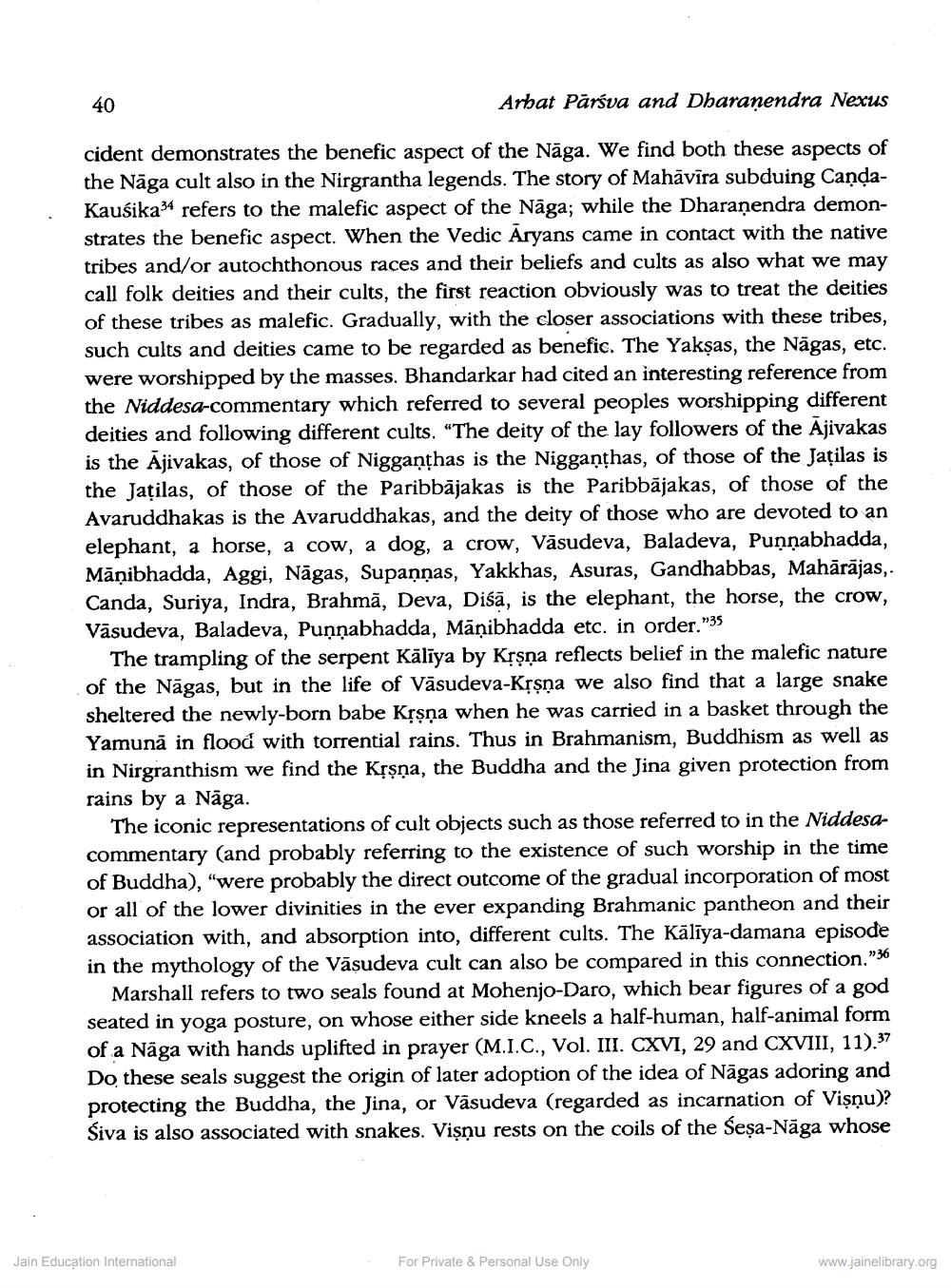________________
40
Arhat Pārsva and Dharanendra Nexus
cident demonstrates the benefic aspect of the Nāga. We find both these aspects of the Nāga cult also in the Nirgrantha legends. The story of Mahāvīra subduing CandaKausika34 refers to the malefic aspect of the Nāga; while the Dharanendra demonstrates the benefic aspect. When the Vedic Aryans came in contact with the native tribes and/or autochthonous races and their beliefs and cults as also what we may call folk deities and their cults, the first reaction obviously was to treat the deities of these tribes as malefic. Gradually, with the closer associations with these tribes, such cults and deities came to be regarded as benefic. The Yakşas, the Nāgas, etc. were worshipped by the masses. Bhandarkar had cited an interesting reference from the Niddesa-commentary which referred to several peoples worshipping different deities and following different cults. "The deity of the lay followers of the Ajivakas is the Ajivakas, of those of Nigganțhas is the Nigganhas, of those of the Jaţilas is the Jațilas, of those of the Paribbājakas is the Paribbājakas, of those of the Avaruddhakas is the Avaruddhakas, and the deity of those who are devoted to an elephant, a horse, a cow, a dog, a crow, Vāsudeva, Baladeva, Puņņabhadda, Māņibhadda, Aggi, Nāgas, Supaņņas, Yakkhas, Asuras, Gandhabbas, Mahārājas, Canda, Suriya, Indra, Brahmā, Deva, Diśā, is the elephant, the horse, the crow, Vasudeva, Baladeva, Puņņabhadda, Māņibhadda etc. in order."35
The trampling of the serpent Käliya by Krsna reflects belief in the malefic nature of the Nāgas, but in the life of Vasudeva-Krsna we also find that a large snake sheltered the newly-born babe Krşņa when he was carried in a basket through the Yamunā in flood with torrential rains. Thus in Brahmanism, Buddhism as well as in Nirgranthism we find the Krsna, the Buddha and the Jina given protection from rains by a Nāga.
The iconic representations of cult objects such as those referred to in the Niddesacommentary (and probably referring to the existence of such worship in the time of Buddha), "were probably the direct outcome of the gradual incorporation of most or all of the lower divinities in the ever expanding Brahmanic pantheon and their association with, and absorption into, different cults. The Kālīya-damana episode in the mythology of the Vāsudeva cult can also be compared in this connection."36
Marshall refers to two seals found at Mohenjo-Daro, which bear figures of a god seated in yoga posture, on whose either side kneels a half-human, half-animal form of a Nāga with hands uplifted in prayer (M.I.C., Vol. III. CXVI, 29 and CXVIII, 11).37 Do these seals suggest the origin of later adoption of the idea of Nāgas adoring and protecting the Buddha, the Jina, or Vasudeva (regarded as incarnation of Vişnu)? Śiva is also associated with snakes. Vişnu rests on the coils of the seșa-Nāga whose
Jain Education International
For Private & Personal Use Only
www.jainelibrary.org




